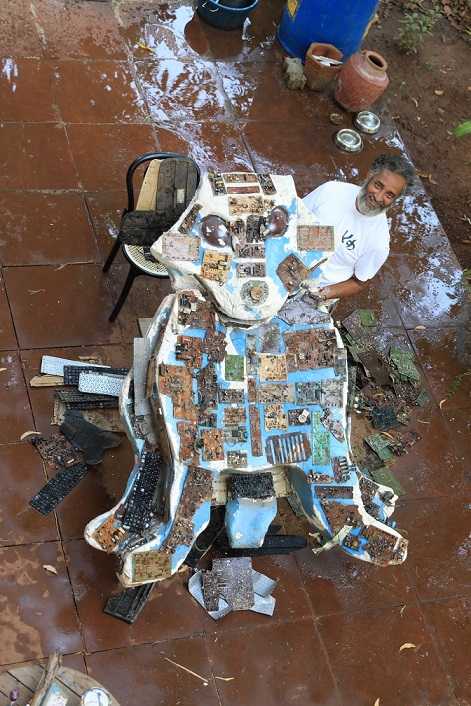What Happened to Baahubali’s 10,000 Weapons? Hint: You Won’t Like The Answer
To make them lightweight, production designer Sabu Cyril got them made in carbon fibre instead of steel. So what happens to such ‘mega productions’?

From the days of silent, black-and-white films, there has been tremendous progress in every aspect of filmmaking. Even the numbers have grown exponentially. Tens of thousands of feature films, documentaries, TV serials, and commercials are made every year, making it an industry worth billions of dollars.
But the one thing that hasn’t changed is the waste generation and the silent damage to the environment! It is in the use of plastics on props and sets, and smoke from action-packed scenes, increasing carbon footprints by the globetrotting crew.
Sadly, including the viewer, no one notices or talks about this.
“Cinema can fill in the empty spaces of your life,” said Spanish filmmaker Pedro Almodovar, known for films like Women on the verge of a nervous breakdown, High heels etc.

He aptly described the role of cinema in our lives. Producers of this profit-making industry will go to any length to ensure that the celluloid world transports us into a Utopia.
For any historical film, huge sets are maintained in a pristine condition until the shoot is complete. Artificial and aesthetic weapons are made. It is reported that for the epic fight scenes in the film Baahubali, nearly 10,000 weapons consisting of swords, helmets, and armour, were created. To make them lightweight, production designer Sabu Cyril got them made in carbon fibre instead of steel, which is recyclable, whereas carbon fibre isn’t.
What happens to the temporary sets or other paraphernalia once the shooting is complete?
“With minute detail, we had constructed the replica of a Boeing 747 plane which was hijacked in 1986, for the film Neerja,” says Aparna Sud, the production designer. Since the film was released in 2016, the ‘aeroplane’ has been lying in a heap in Nitin Desai’s famous ND film studio near Mumbai.

Sud has won several awards, including the Filmfare, Zee Cine Award, and an International Indian Film Academy Award for this film’s production design. Although she loves her job, she regrets the waste generated by her work.
“At the end of the shoot, we just pay Rs 3,500 per truck of waste, and our responsibility ends! Some items like iron and wood may be retrieved by the kabadiwalas, but the rest of that waste goes to landfills,” accepts the set designer.
Like other production designers, she too retrieves many items from her sets and stores them to be used in other shoots later.
Another award-winning production designer, Sukant Panigrahy, says, “Many times, I tried to initiate a dialogue with the officers at the Film City (Dadasaheb Phalke Chitranagari) in Mumbai about starting a waste management centre on the premises. But the talks never concluded. Even when I was working with Yash Raj Films, I tried; the problem was accepted, but it was never given serious thought.”
Art director and designer of films like Chak De! India, Dev D, Tashan, Ek Tha Tiger, Panigrahy has started waste recycling in his capacity. More than a design director, he wishes to be known as an installation artist and collects reusable items like pipes, nuts, bolts, and flex sheets from his film sets. Some of these were displayed at the 2013 Kala Ghoda Art Festival in Mumbai.

Set materials like Flex sheets aren’t recyclable and damage the environment extensively. They are painted, used as backdrops on film sets and name boards for shops or advertising hoardings. They are made of PVC (Polyvinyl chloride) and don’t decompose.
Other items used in large quantities are plastic cups, plates, small mineral water bottles, hand tissues used in makeup and supari packet wrappers.
Besides these materials, carbon footprints are added when the crew goes on location hunting or visit the location to shoot. Large generators are used, and the damage is greater in an action film due to the use of smoke, which harms the air quality.
“We have to accept that some kind of waste will be generated on the film sets, with damage to the environment, but the new trend is to minimise the damage as much as possible. A lot of things depend on the story; for example, if the story is based abroad, then one has to fly. But that part is minimised if it is based in India,” explains Ravi Popat. He’s the award-winning art director of the Gujarati film, Hellaro.
Luckily for Popat, Hellaro’s story was Kutch-based. So, he used local material to build 15 Bhungas (traditional houses of Kutch, Gujarat) and labourers, with minimal waste.

Another new trend is to rent equipment from local outlets even when shooting abroad, except cameras. Even the support crew and actors are hired locally. This not only cuts costs but also reduces travel miles. The crew, including directors and actors, have also started replacing plastic water bottles with flasks which are refilled from common storage units.
To reduce travel miles and damage to the environment, big guns in the industry with no financial restraints, use VFX (visual effects) and CGI (computer-generated imagery) to get the required effect. For example, 90 per cent of the action and scenic beauty of Baahubali was created on VFX.
“There is increasing use of this technique. And if done well, only experts can identify that it is not a real location. We have expertise but fall short on finances. Hollywood films have immense budgets which help their films look better with these new techniques,” says Ramesh Meer, the chief creative director and CEO of the FX Factory.
In nearly five decades, he has made hundreds of films, including Hum Dil De Chuke Sanam, Pardes, Don and television serials and commercials.

Meer agrees that the increasing use of VFX and CGI will reduce the damage to our environment. In fact, in the latest film, War, a majority of the chase scenes between Hrithik Roshan and Tiger Shroff in the Arctic Circle were done on VFX and CGI.
Although many in India are using this technique, others are strapped for finances and depend on real location shooting. And they are the ones who need to be careful.
Meer says that VFX and CGI will be preferred if budgets are increased, which will help decrease the waste and carbon footprints.
Also Read: Here’s Why These Mumbai Scriptwriters & Engineers Become Idol-Makers Once a Year!
In Hollywood, special NGOs like the Ecoset and Earth Angles are hired by filmmakers to manage their waste. The Indian film industry needs to wake up. People like Sud, Panigrahy, Popat are willing to work, and all they need is a little help from the film fraternity.
(Edited by Shruti Singhal)
Like this story? Or have something to share?
Write to us: [email protected]
Connect with us on Facebook and Twitter.
If you found our stories insightful, informative, or even just enjoyable, we invite you to consider making a voluntary payment to support the work we do at The Better India. Your contribution helps us continue producing quality content that educates, inspires, and drives positive change.
Choose one of the payment options below for your contribution-
By paying for the stories you value, you directly contribute to sustaining our efforts focused on making a difference in the world. Together, let’s ensure that impactful stories continue to be told and shared, enriching lives and communities alike.
Thank you for your support. Here are some frequently asked questions you might find helpful to know why you are contributing?


This story made me
-
97
-
121
-
89
-
167













